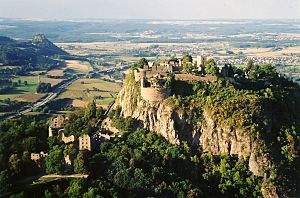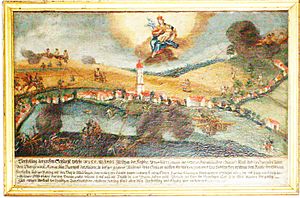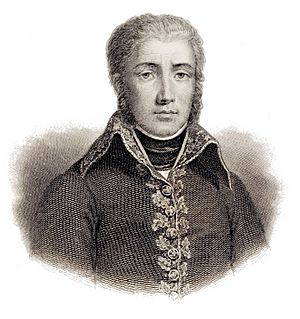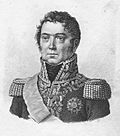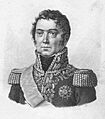Battle of Ampfing (1800) facts for kids
Quick facts for kids Battle of Ampfing (1800) |
|||||||
|---|---|---|---|---|---|---|---|
| Part of the French Revolutionary War | |||||||
 The hilly terrain around Ampfing is characterized by open fields, dense woods, and villages and farms. |
|||||||
|
|||||||
| Belligerents | |||||||
| Commanders and leaders | |||||||
| Paul Grenier | Archduke John of Austria | ||||||
| Strength | |||||||
| 18,000 | 27,000 | ||||||
| Casualties and losses | |||||||
| 1,707 | 3,070 | ||||||
The Battle of Ampfing took place on December 1, 1800. It was part of the French Revolutionary Wars, a series of major conflicts in Europe. In this battle, the French army, led by General Paul Grenier, fought against the Austrian army. The Austrians were commanded by Archduke John of Austria.
The battle happened southwest of the town of Ampfing in what is now Germany. Ampfing is about 63 kilometers (39 miles) east of Munich. Even though the Austrians had more soldiers, they suffered greater losses than the French. The French army had to retreat, but they did so in an organized way.
After this battle, the Austrian leaders thought the French were running away. They decided to chase them through a thick forest. However, the French commander, Jean Victor Marie Moreau, was actually waiting for them. Two days later, the two armies met again in the very important Battle of Hohenlinden.
Contents
Understanding the Conflict
The Battle of Ampfing was a small but important part of the larger French Revolutionary Wars. These wars involved France and many other European countries. They started after the French Revolution in 1789.
Why the War Started Again
In 1797, a peace treaty called the Treaty of Campo Formio was signed. But it was hard to make it work. Austria was slow to give up some lands. Also, there were uprisings in Switzerland and Italy.
By 1799, France was tired of the delays. Napoleon Bonaparte, a powerful French leader, wanted to continue fighting. He planned to attack Austria from two directions: northern Italy and southern Germany.
Armies Ready for Battle
In early 1800, the French and Austrian armies faced each other. The Austrian army, led by Pál Kray, had about 120,000 soldiers. This included troops from Bavaria and Württemberg.
The French army, led by Jean Victor Marie Moreau, had even more soldiers, about 137,000. Moreau decided to cross the Rhine River near Basel. He used clever moves to outsmart Kray's army.
Battles happened at Engen and Stockach on May 3, 1800. The fighting was tough, and both sides lost many soldiers. The French captured Stockach, which was a main supply base for the Austrians. This forced Kray to retreat.
More fighting took place at Meßkirch on May 4 and 5. The French attacked many times but couldn't win easily. However, they gained control of nearby high ground. This forced Kray to retreat again.
On May 9, the Battle of Biberach happened. The French attacked the Austrian forces. Again, the Austrians had to retreat, this time to Ulm.
Controlling the Danube River
France's main goal was to reach Vienna, the capital of Austria. To do this, they needed to control the Danube River. This river was very important for moving troops and supplies. Many big battles had been fought along the Danube before.
The French won battles at Höchstädt and Neuburg in June 1800. This gave them control of the Danube crossings. The Austrians lost control of this important river.
Around the same time, Napoleon won important battles in Italy, like the Battle of Marengo. With French armies pushing from both the north and south, Austria agreed to a ceasefire. This meant a temporary stop to the fighting.
A Short Break in Fighting
On July 15, 1800, France and Austria agreed to a truce. This ended the summer fighting in southern Germany. The Austrian Emperor, Francis II, replaced his commander, Pál Kray. He put his 18-year-old brother, Archduke John, in charge. To help the young Archduke, experienced generals were appointed to guide him.
Both armies got ready for more fighting. The truce was extended until November 12, 1800. As part of the agreement, Austria gave some fortresses to the French. This allowed Austria to add more soldiers to their main army. Peace talks continued, but they were difficult.
Fighting Starts Again
The truce ended on November 12, 1800. The Austrians had about 124,000 soldiers spread out. Archduke John's main army was near the Inn River.
The French had an even larger army. Moreau commanded about 107,000 soldiers. His plan was to advance eastward. He wanted to push the Austrians back to the Inn River.
The Austrian chief of staff, Franz von Weyrother, convinced Archduke John to attack first. They planned to strike towards Landshut. However, the Austrian army moved too slowly. So, they changed their plan to a direct attack on Munich.
The Battle of Ampfing
On the morning of December 1, 1800, the Austrian army was ready to fight. Their advance guard was already in Ampfing.
General Johann Riesch led about 14,000 Austrian soldiers out of Ampfing. Another Austrian force, led by Ludwig Baillet de Latour-Merlemont, attacked on Riesch's right side. Latour's troops surprised the French division led by Michel Ney.
Even though they were greatly outnumbered, the French 19th Cavalry Regiment bravely charged the Austrians. This gave General Ney enough time to get his soldiers ready. Ney's division had about 8,200 infantry and 1,100 cavalry.
Ney's soldiers fought well, even counterattacking when more French cavalry arrived. French artillery also helped, firing accurately at the Austrians.
While Latour attacked Ney, Riesch attacked another French division led by Jean Hardy. More French troops arrived to help defend Hardy's side. During the fighting, Hardy was wounded, and command went to General Louis Bastoul.
Both French divisions were slowly pushed back by the larger Austrian forces. General Grenier then ordered a retreat.
The French retreated in an organized way towards Haag. They even charged the Austrians to save some cannons. After retreating about 8 km (5.0 mi), the French set up new defenses in an open area. The battle lasted for six hours.
Result
The Battle of Ampfing was a tactical victory for the Austrians. They forced the French to retreat. However, the Austrians suffered more losses. They had 303 killed, 1,690 wounded, and 1,077 captured. The French lost 193 killed, 817 wounded, and 697 captured.
The next day, the Austrian generals expected another big battle. But they were surprised to find that the French had left Haag and disappeared into the thick woods.
The Austrian leaders, especially Archduke John and Weyrother, were very happy with their victory. They believed the French were truly running away. This made them overconfident. They decided to chase the French towards Hohenlinden.
However, General Moreau and his French troops were not fleeing. They were waiting for the Austrians in the Hohenlinden plain. Two days later, on December 3, 1800, the two armies met in the decisive Battle of Hohenlinden. The French ambushed the Austrians as they came out of the forest, winning a huge victory.
This major French victory, along with Napoleon's win at the Battle of Marengo earlier that year, ended the War of the Second Coalition. In February 1801, Austria signed the Treaty of Lunéville. This treaty gave France control of lands up to the Rhine River. It also recognized French control over new republics in Italy and the Netherlands. This led to a period of peace between France and Britain.
Sources
- Arnold, James R. Marengo & Hohenlinden. Barnsley, South Yorkshire, UK: Pen & Sword, 2005. ISBN: 978-0967098500
- Beattie, Andrew. The Danube: A Cultural History. Oxford University Press, 2010. ISBN: 9780199768356
- Blanning, Timothy. The French Revolutionary Wars, New York, Oxford University Press. ISBN: 978-0340569115
- Sloane, W.M. Life of Napoleon. France, 1896 (reprint, 1910).
- Pivka, Otto von (pseud). Armies of the Napoleonic Era. New York: Taplinger Publishing, 1979. ISBN: 0-8008-5471-3
- Smith, Digby, Napoleonic Wars Databook. London: Greenhill Press, 1998.
External sources
- napoleon-series.org Ludwig Baillet by Digby Smith, compiled by Leopold Kudrna
Images for kids


